Let me introduce you to an articulate and talented artist who celebrates his heritage every day. Many people know him as Diego Juárez Viveros, but he is Atlachinocolotl Paquiliztli on Facebook and in the dance community.
He moved from Michoacán, México, to the United States when he was 4 years old. As you will see, he has accomplished quite a lot since then!
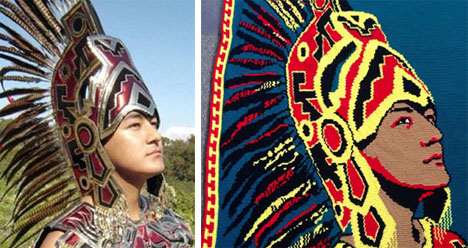
Atlachinocolotl Paquiliztli, 2005, and his tapestry crocheted Aztec Dancer, Red Heart acrylic yarn, 5′ x 2’6″, 2013.
He explains, “All of my life, I have stood out for being out of the ordinary for many reasons. I stood out in school for my excellence in academic achievement. Despite growing up in a family with low economic means, I have found ways to become successful. After graduating from high school with an outstanding academic record, I pursued a biochemistry degree at University of California, San Diego and graduated in 2008. I then decided to pursue a career in pharmacy and I was accepted to University of California, San Francisco School of Pharmacy. In September 2013, I completed the Doctor of Pharmacy degree program.”
“I put a lot of passion in everything I do. Aside from crochet, I am interested in astronomy, photography, technology, and learning languages. I speak Spanish and English very fluently. I am currently learning Nahuatl. Nahuatl is an agglutinative language, which means that words are constructed by combining word particles in order to form single ideas. My name can be broken down as “atl” + “tlachinolli” + “colotl”, which mean “water”+ “burnt” + “scorpion”, respectively. My name means Burnt Water Scorpion. “Paquiliztli” means happiness.”
Atlachinocolotl Paquiliztli’s unique tapestries are crocheted back and forth, but instead of showing the back of the stitches on every other row, the face of his fabric shows only the front of the stitches. There are a few ways to accomplish this, so I asked him how he did it. He explained, “When I crochet in the opposite direction, I crochet backwards just like it is described in your book. I hold the right side forward and the wrong side toward me. Then I use my right hand to crochet. You can see a little in the photograph of me crocheting that way (below).”
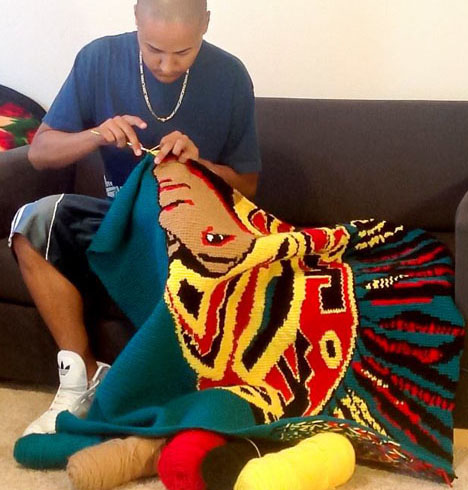
Atlachinocolotl crocheting across the back of his Aztec Dancer with Red Heart acrylic yarn, 2012.
“In 2010, I saw my mother crocheting a piece and I asked her to show me how to crochet. She showed me how to do single crochet and, instantly, I was hooked (hehe). I started experimenting with crocheting that day. I wanted to know more. So I bought some books to learn the basics of crochet. I made some rather simple projects at first. After much experimentation and exploration, a vision of what I wanted started to take hold: I wanted to recreate pictures with crochet. I set off on a quest to find out more information about switching colors but I could only find basic instructions. I started making basic pieces with two colors to experiment at first. I created charts using square graphs. The designs came out okay, but I wasn’t satisfied.”
“The piece below was my first attempt at creating a tapestry crochet piece (at that time, I didn’t know the term). The pattern was modeled on a square graph paper. The piece was crocheted with double crochet stitches, using blue and white Omega Crys yarn. While creating this project, I learned the basics of switching colors to create a pattern.
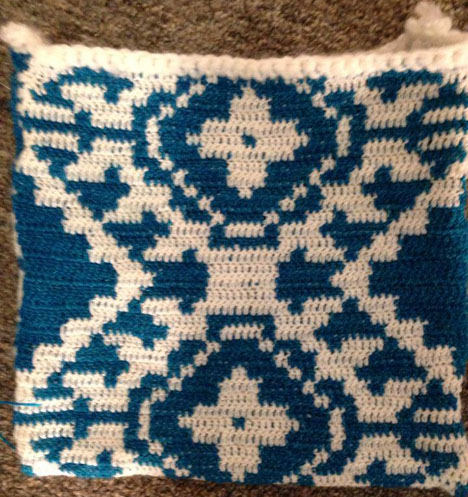
- Bag, Omega Crys acrylic and polyester yarn, 8″ x 8″, 2010.
“One day, I came across your videos on YouTube. That is how I realized that pictures could be reproduced using tapestry crochet. I began to experiment. My first major crochet piece (The Aztec Dancer) was modeled on a square graph. With this project I began to understand the intrinsic structure of single crochet and figuring out how to reduce bleeding of colors. I realized a square graph is not an adequate model for tapestry crochet but that the stitches are better Erica the Mexican Folkloric Dancer modeled by a hexagonal graph. I spent an entire day figuring out how to overlay a hexagonal graph over a picture in Photoshop. Once I figured that out, I had a working model.”
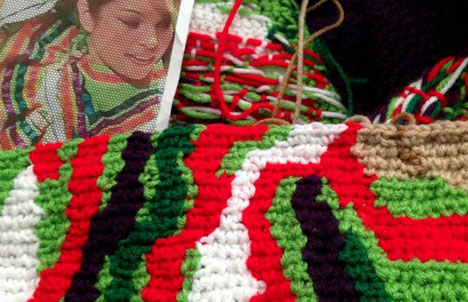
Graph, front, and back of Erica the Mexican Folkloric Dancer.
“I then started crocheting. With this most current project, I refined my technique more and created ways to make lines crisper with single crochet.” He describes the Erica the Mexican Folkloric Dancer tapestry in a short YouTube video.

Erica the Mexican Folkloric Dancer, Red Heart acrylic yarn, 3′ x 6′, 2013.
When I asked about his yarn and hook preferences, he said, “It depends on the type of project I will be making. In general, I prefer bright colors so I pick yarn brands that provide those colors. For projects that require fine detail, I like to use Omega Crys, which is a fine yarn (size 10) made of 68% acrylic and 32% polyester. It is imported from Mexico and is available in a wide variety of bright colors. For fine projects I use a 2.00 mm hook. For bigger projects, such as the colorful blankets I have made, I use Red Heart yarn (size 4) with a Size E hook.”
For his newest piece, Atlachinocolotl Paquiliztli digitized his own scorpion drawing with a pen tool, then layered a hexagonal graph over it in Photoshop.

Atachinocolotl’s scorpion graph.
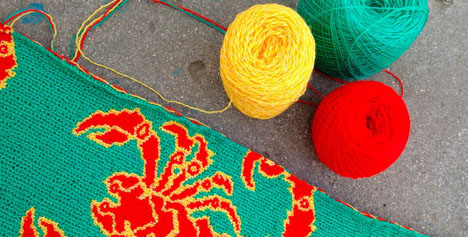
Colotl Scorpion in progress, Omega Crys acrylic and polyester yarn, 2013.
“This is my most recent piece. I crocheted it with a 2.00mm hook and tapestry single crochet techniques. This project is different from my previous projects for two reasons. This is the first time in which I have incorporated beads in a project. It is also the first time in which I joined another fabric in the back in order hide the yarn that I carry in the back.”
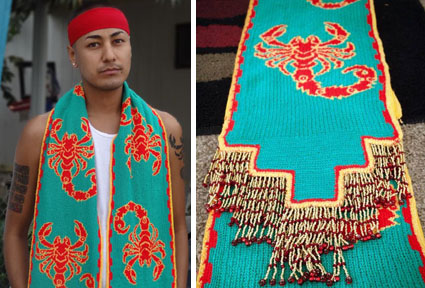
Atlachinocolotl Paquiliztli and Colotl Scorpion, OmegaCrys acrylic and polyester yarn and glass beads, 7′ 3″ x 8 3/4″, 2013.
“After seeing the huge online response to my work, I intend to teach about my technique. After comparing my results with those of others, I realized that my techniques allow for crisper edges with single crochet. I plan on writing an ebook in iBooks format. This book will include pictures, text and video explaining my technique. It will have designs inspired by my Mexican background. It will include the patterns for the Aztec Dancer and the Mexican Folkloric Dancer as well as some more of my ideas. I am currently undergoing a huge life transition since I have just graduated from pharmacy school. You should expect to see my book within 1-2 years.”
I don’t know about you, but I’m really looking forward to seeing Atalachinocolotl Paquiliztli’s future work – both his tapestry crochet and his publications!